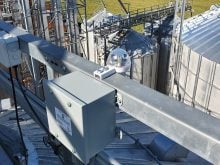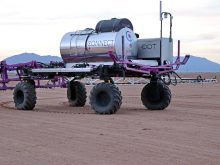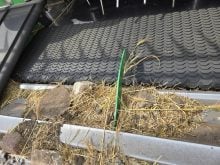Fall anhydrous can be a headache. You want to put down high rates, but cold weather causes low tank pressure, freezing lines and frozen openers that won’t function properly.
High pressure can solve the frozen opener problem, according to Cameron Stewart of Max-Quip Incorporated in Calgary. He says high pressure in the Maxflow VRC II NH3 system allows better accuracy at high and low rates, quick changes under variable rate and a simplified system that does away with the cooler.
“Anhydrous ammonia is very difficult to regulate and meter in any variable rate situation, regardless of air temperature,” says Stewart, adding that cold weather in late fall and early spring makes a bad situation worse.
Read Also

Organic farmers urged to make better use of trade deals
Organic growers should be singing CUSMA’s praises, according to the Canadian Chamber of Commerce.
“Higher pressure with smaller lines lets you accurately deal with reduced rates at the low end and accurately push more product through at high rates.
“It’s because a liquid product is always easier to handle and regulate than vapour. We keep the anhydrous ammonia in a liquid state by keeping it under high pressure. The lines are only 1/8 of an inch (inside diameter) and they’re rated for 250 psi working pressure. They can be secured to most standard manifolds using a compression fitting.”
To make this happen, Stewart says a Max-Quip positive displacement vane pump is mounted as close as possible to the nurse tank with the intake below the level of the nurse tank belly.
The pump is driven by a hydraulic motor. Varying the speed of the motor varies the rate going out to the distribution manifolds. The pump replaces the control valve used on conventional systems.
Motor speed is controlled by an automatic rate controller, which interprets signals from a flow meter and a ground speed indicator.
The rate can be adjusted on the go by making adjustments to the application rate in the rate controller.
It can also be varied by a task controller with a prescription map and a GPS signal. Systems can be configured to work with most automatic rate controllers.
Stewart says the pump makes the system work, especially in low temperatures. As long as ammonia is under pressure, it remains in the liquid form and doesn’t freeze.
“Fall is when farmers typically try to put down high rates. But tank pressure drops as the outside air temperature drops, so they don’t have the pressure they need.
“They’re trying to pull a 60 foot frame at seven mph and put down 120 pounds per acre, and it just doesn’t work.
“They end up with almost zero manifold pressure and the distribution accuracy goes all to hell.”
The pump inserts new energy into the application operation, says Stewart. Energy from the tractor’s hydraulics is transferred into the NH3 system via the hydraulic motor and positive displacement vane pump. The energy creates pressure, keeping the NH3 in a liquid state.
This not only benefits the producer applying high rates in the fall, it also helps producers who may want to put down low rates at seeding time, but are concerned about accuracy.
“If you only need 30 lb., you now can get it with consistency and accuracy. At all rates, high manifold pressure is easier to handle than low manifold pressure.
“For variable rate, high pressure provides almost instant response from zone to zone. Same thing when you get to the headlands. It shuts off almost instantly and comes back on almost instantly.
“This is because the on-off valves are right on the manifold, so the system remains fully pressurized right up to the manifold. The hose from the manifold to the opener is so small, there’s very little product left in the line when the valves are off.”
High pressure also eliminates the need for a cooler and the necessity of a vapour escape line running down to an opener, which sends more nitrogen to that seed row.
The pump ensures that system pressure is always higher than tank pressure. An in-line, pressure-compensated, back-pressure regulating valve keeps NH3 in a liquid state in the flow meter, to ensure accurate measurement. As a result, the system knows that it’s always metering liquid, never vapour.
“We get no frost on the lines, no frozen openers and no footballs being dragged around in the field.
“The result is accurate NH3 placement where you want it, along with better sealing.”
Overall capacity is two to 2.5 percent of the nurse tank storage capacity per minute. This varies with temperatures of liquid, atmosphere and intake line restrictions.
For example, a 2,000 gallon nurse tank will be limited to 50 gallons per minute (12,644 lb. of nitrogen per hour) maximum withdrawal rate.
Electric valves can be installed on each manifold to provide individual boom section control, controlled manually or integrated into a GPS automatic boom section control system.
In addition to sectional control of the system, manifold valves also provide for a quicker on-off response time.
Stewart says there are nearly 100 Max-Flow systems on prairie farms.
The system is built in Saskatoon and sells for $16,000 to $22,000.
For more information, call 800-667-5886 or visit www.maxquip.ca.















